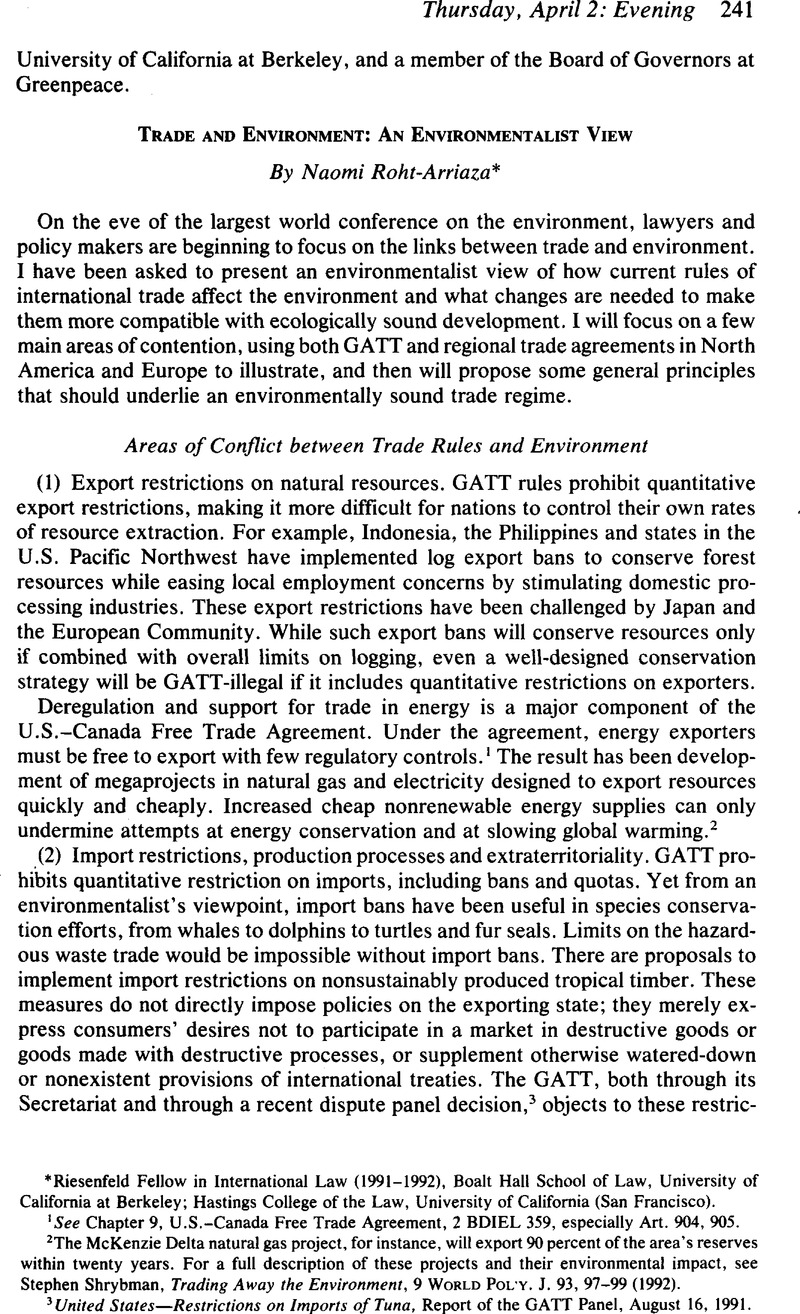No CrossRef data available.
Published online by Cambridge University Press: 28 February 2017

1 See Chapter 9, U.S.-Canada Free Trade Agreement, 2 BDIEL 359, especially Art. 904, 905.
2 The McKenzie Delta natural gas project, for instance, will export 90 percent of the area’s reserves within twenty years. For a full description of these projects and their environmental impact, see Stephen Shrybman, Trading Away the Environment, 9 WORLD POLY. J. 93, 97-99 (1992).
3 United States—Restrictions on Imports of Tuna, Report of the GATT Panel, August 16, 1991.
4 Stockholm Declaration on the Human Environment, Principle 21, UN Doc. A/Conf.48/14 (1972), reprinted in 11 ILM 1416, 1420(1972).
5 See MARK JANIS, AN INTRODUCTION TO INTERNATIONAL LAW 245-47 (1988).
6 See panel decision on tuna, supra note 3. The panel found that the Marine Mammal Protection Act (MMPA) provisions at issue could not be considered internal regulations because they made no difference to the sale of tuna as a product, only to how it was produced. Thus, the provisions were a quantitative restriction on imports and would be allowed only if they came within an exception to GATT.
7 See United States—Restrictions on Tuna Imports, GATT, August 16, 1991. Mexico challenged provisions of the U.S. Marine Mammal Protection Act permitting the U.S. tuna fleet to kill up to 20,500 dolphins per year in the Eastern Tropical Pacific, while requiring foreign fleets to kill not more than 1.25 times the average U.S. kill rate per “set” on dolphins.
8 See Stephen Shrybman, Selling the Environment Short: An Environmental Assessment of the First Two years of Free Trade between Canada and the United States, Canadian Environmental Law Association, November 1990. The challenge to The U.S. Environmental Protection Agency’s asbestos regulations was eventually decided without reference to their GATT-compatibility. See Corrosion Proof Fittings, et al. v. EPA, No. 89-4596, 947 F.2d 1201 (5th Cir. 1991).
9 The relevant provisions of Article XX read: Subject to the requirement that such measures are not applied in a manner which would constitute a means of arbitrary or unjustifiable discrimination between countries where the same conditions prevail, or a disguised restriction on international trade, nothing in this Agreement shall be construed to prevent the adoption or enforcement by any contracting party of measures:
....
(b) necessary to protect human, animal or plant life or health;
....
(g) relating to the conservation of exhaustible natural resources if such measures are made effective in conjunction with restrictions on domestic production or consumption.
10 Canada—Measures Affecting Exports of Unprocessed Herring and Salmon, BISD 35S/98, 114 (1989) (analyzing Article XX(g)).
11 Thailand—Restrictions on Importation of and Internal Taxes on Cigarettes, BISD 37S/200 (1990). The panel used this narrow interpretation of Article XX(b) to find against a Thai ban on foreign cigarette imports. The Thais had argued that even though they allowed the sale of domestic cigarettes through a government monopoly, they carefully controlled the amounts and types sold as part of a program to reduce smoking; that U.S. cigarettes were more aggressively marketed toward new smokers; and that they contained additives that encouraged new smokers. The panel rejected these arguments because it found that alternative antismoking strategies existed. Yet the strategies it proposed—ingredient disclosure labels on packages and limits on advertising—were either not as effective as a ban or were already being implemented. (¶¶74—81.)
In the recent panel decision on tuna and dolphins, the panel upheld a Mexican challenge to portions of the U.S. Marine Mammal Protection Act, 16 USC §1371 (a)(2)( 1990) imposing a ban on tuna imports if harvested in a manner resulting in excessive dolphin mortality. Interpreting Article XX(b), the panel required the regulating party to show it has exhausted all other options reasonably available. Multilateral options were considered an alternative, not a complement to national laws. Furthermore, the panel went on to consider the validity of the MMPA provisions as public policy, finding they were not “necessary” because they were based on “unpredictable conditions” (¶5.28). Whether or not one agrees as a policy matter, surely there is no legal basis for such an interpretation.
12 Supra note 10; see also Canada’s Landing Requirement for Pacific Coast Salmon and Herring, Final Report of the FTA Panel, October 16, 1989, ¶¶7.02-7.08.
13 For example, the Delaney Clause of the U.S. Food and Drug Act or Canada’s pesticide regulations are both health-based. Under the U.S.-Canada Free Trade Agreement, Canada has agreed to work toward “equivalence” with the U.S. regulatory approach. See Stephen Shrybman, supra note 2, at 93, 105.
14 OECD, GUIDING PRINCIPLES CONCERNING INTERNATIONAL ECONOMIC ASPECTS OF ENVIRONMENTAL POLICIES, Recommendation c(72)128, adopted May 26, 1972, reprinted in 11 ILM 1172 (1972). The PPP “means that the polluter should bear the expenses of carrying out the . . . measures decided by public authorities to ensure that the environment is in an acceptable state. In other words, the cost of these measures should be reflected in the cost of goods and services which cause pollution in production and/or consumption.”
15 See Sanford E. Gaines, The Polluter-Pays Principle: From Economic Equity to Environmental Ethos, 26 TEX. INTL L. J. 463, 489 (1991). For a slightly different version, see Alan NEFF, Not in Their Backyards, Either: A Proposal for a Foreign Environmental Practices Act, 17 ECOLOGY L. Q. 477 (1990).